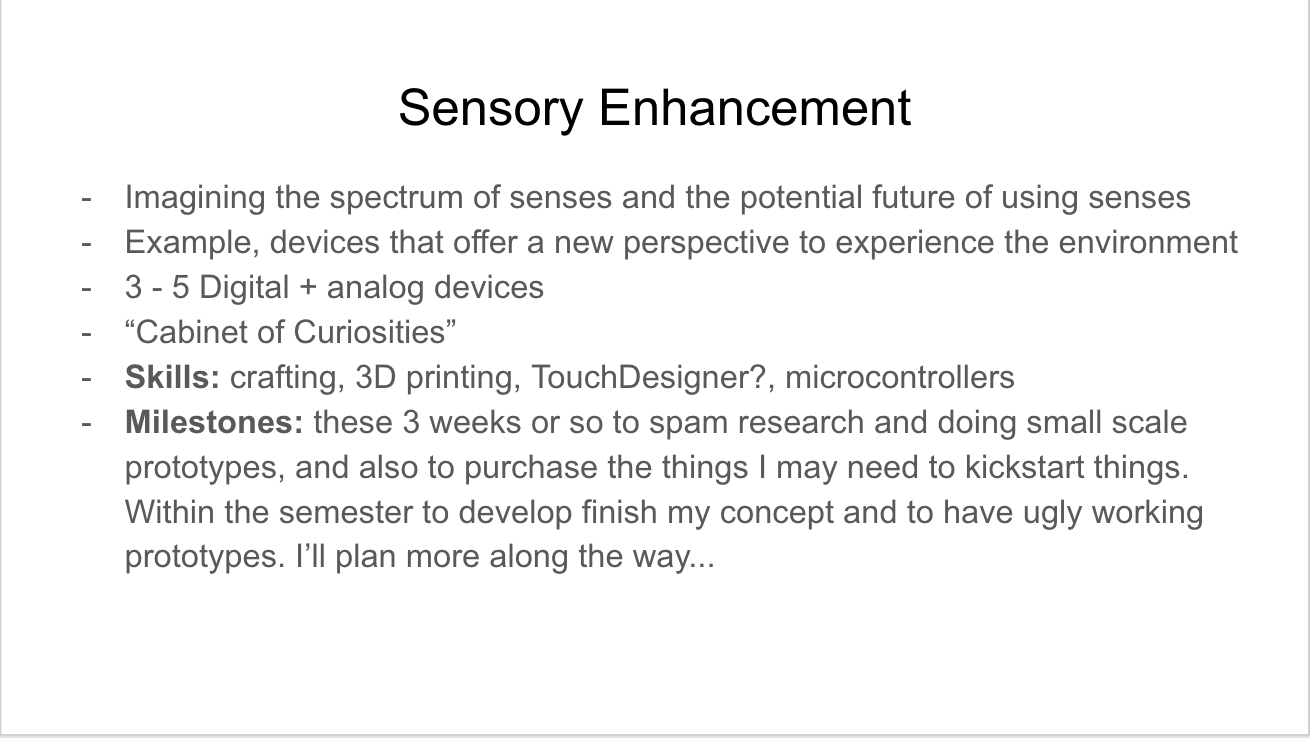Oops I forgot to talk about skills and milestones during the presentation so I’ve added them.
Human 2.0
What is Human 2.0?
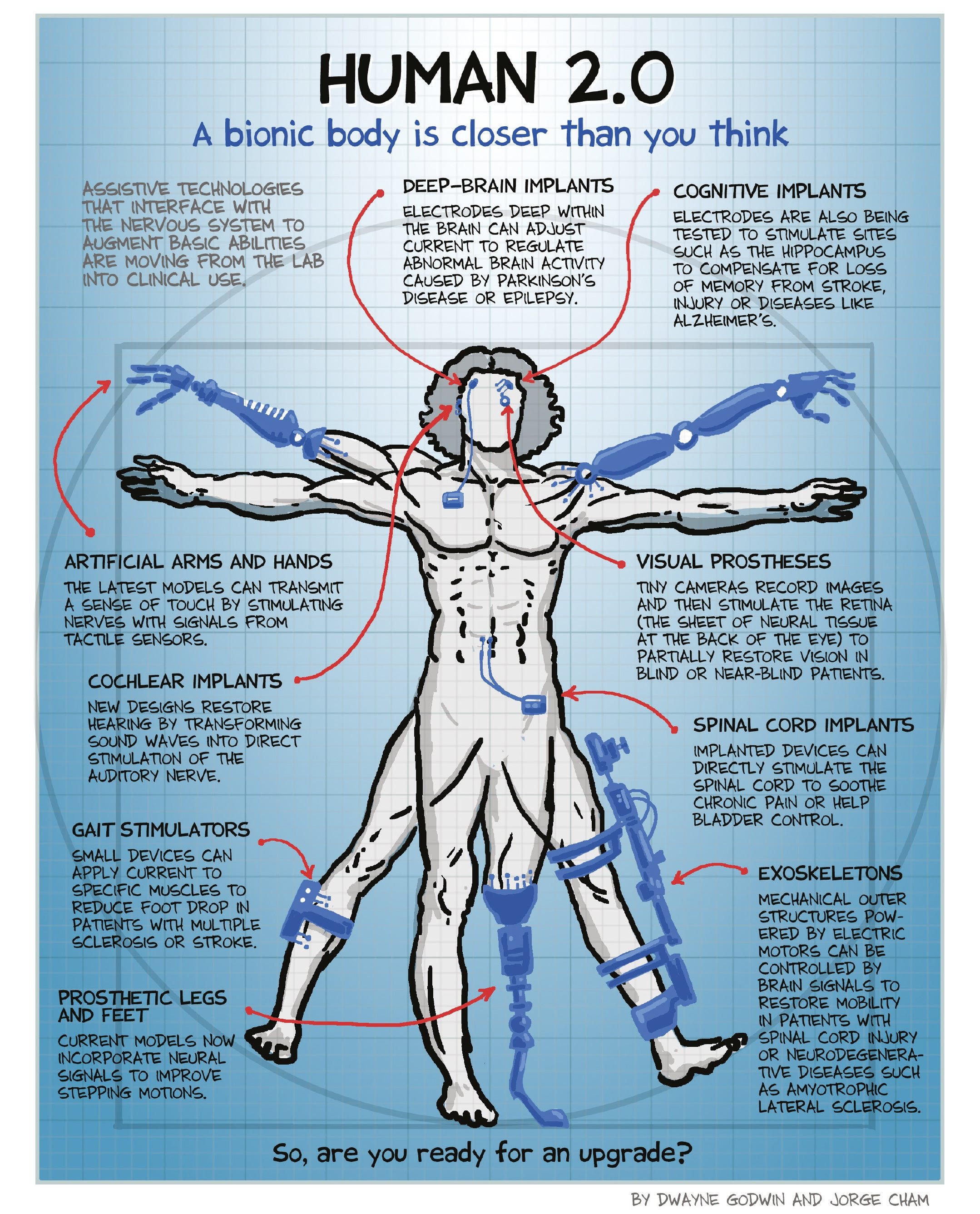
Our affinity with technology is ever growing. As technology gets closer and closer to us, the boundaries between human and machine gets blurred. The idea of Human 2.0 is the fusing of technology within the human body as a means to augment ourselves through the use of technology in prosthesis, wearables, implants, or body alteration, bringing us a spectrum of new senses and improved function that cannot be experienced without the upgrade.
This idea isn’t new, as many Cyberpunk-styled animations, films, and games like Ghost In The Shell, Blade Runner, and Overwatch have already imagined scenarios of human-technology augmentation.
Hacking in “Ghost in the Shell”

Sombra is one of the cybernetically enhanced characters in Overwatch that has augmented abilities like “hacking”

Joker (of suicide squad), except he isn’t trying too hard and sees in drone in Blade Runner 2049
These characters with augmented abilities can be categorised under cyborgs, which are people who are augmented to have capabilities higher than human through cybernetics enhancements. Cyborgs are a vision of Human 2.0 which is very popular in science fiction especially in the Cyberpunk genre — and it’s becoming a reality. We are now at the beginning of the transhuman era where we will all evolve alongside with technology as we fuse with it. This begun from analog augmentations like the spectacles and simple prosthetics like wooden legs. Now, we have various technology that allow us to surpass our physical limitations like controlling a prosthetic arm with our mind and the Third Thumb prosthetic
Case Study

Neil Harbisson is the first person to have implanted an antenna on his head which allow him to translate colour into sound by converting light into a frequency which Neil is able to hear as a note. This was done to combat his achromatopsia which is a condition that allows him to only see in greys. With this augmentation, he is able to use technology to help him see more than what he previously lack.
I don’t feel like I’m using technology, or wearing technology. I feel like I am technology. I don’t think of my antenna as a device – it’s a body part.” He wears it to bed and in the shower.
He identify colours by first memorising and learning them. After getting used to the tones, he then start to subconsciously perceive the information. Finally, when he started to dream in colours, he felt that he officially became whole with the device, and that is when the brain and software united, turning him into a cyborg.
In this video, he explains to the audience on how his experience with the world have changed. He began to dress in terms of how it sounds rather on how it looks, and eat in arrangements of his favourite tune. He is also able to now hear colours as he is able to associate the tones with the colours that he perceive.
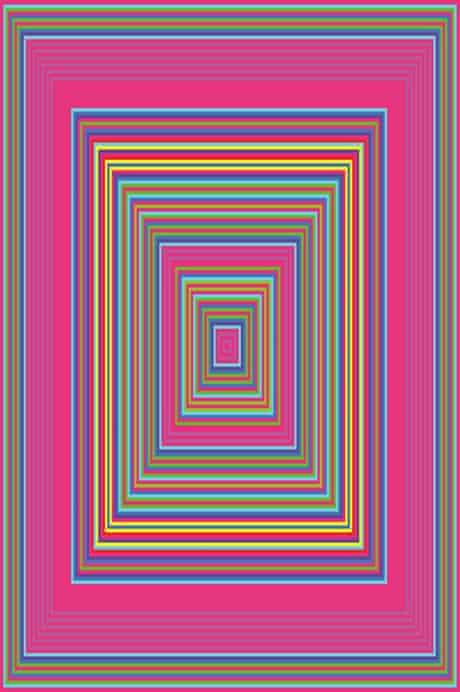
He further upgraded that he can hear infrared and ultraviolet, as well as allow for bluetooth and wifi connection in his ‘eyeborg’.
Neil’s ability to process the new senses is possible due to “neuroplasticity”, which are ways that the brain is able to rewire itself as it tries to interpret information through a stimuli. Essentially, our senses are all the same, in which they take in an input and convert it to information for the brain to process which allows us to perceive.
How does the Eyeborg work?
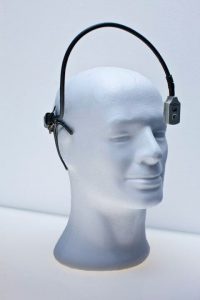

The eyeborg receives lightwaves through the camera in front, which then converts the information into sound pitch from the implant within his head. The pitch is then sent to his eardrums through bone conduction.
Harbinsson’s Eyeborg have been exhibited in Singapore Art Science Museum before. The sensor is connected via wifi to allow him to sense the colours that are detected in front of the sensor in the exhibition
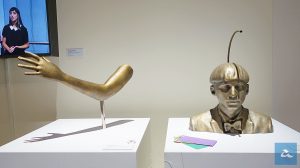
Side note, but In one of the article, I find it funny that Neil have mentioned about something which my Bart-I device deals with:
What next for cyborgism? “We’ll start with really simple things, like having a third ear on the back of our heads. Or we could have a small vibrator with an infrared detector built into our heads to detect if there’s a presence behind us.” Like a car’s reversing sensor? “Yes. Isn’t it strange we have given this sense to a car, but not to ourselves?”
“Precisely” – Me
Analysis / Critique
I think the eyeborg is only the beginning of what human upgrades can be. It is super interesting to be able to perceive something that we normally cannot. It’s like trying to imagine a colour that we have never seen before. I’m having some trouble thinking and writing this as it is hard to try to imagine what’s next in terms of the senses one can use to perceive the world.
Still, it’s good that there’s proof that humans and technology can unite as one, as long as the human have enough exposure to the technology such that it becomes an intuitive and incorporated tool they use, like an extended organ. There is still many possibilities in future for this.
However, I think it’s still a very primitive way for us to perceive. Most of these extended senses require the sacrifice or use of some other senses. For example, the eyeborg requires the user to have a sense of hearing in order for it to be used. The 3rd thumb also requires the use of big toes. These means of controlling or using the ‘new’ senses is still not perfect and could be more incorporated into the brain such that it can be directly sensed or directly controlled.
Dreams…
One thing I find really interesting about Neil is how he dreams in his new sense. This is very familiar to me after thinking about it for a while as I had dreams about games where the game mechanics and everything works as it is in the actual game. These mechanics in my dreams are also vivid which really emulates how I will play the game in real life. What I’m trying to say here is, by Neil’s definition, we are all already cyborgs!
Ethical?
There is also a question of ethics. Is it ethical to allow people to customise themselves such that they can sense new senses? Challenges that define human life can be nullified. How will we define humans then? Will we like what the future brings? Will it cause more discrimination or segregation?
I think this is not something we should worry as we will eventually adapt and like it whether or not as we’re now speaking in our perspective as non-transhumans. If something is beneficial to us as a whole, it will eventually become widely accepted.
Intrusiveness
Another con is how intrusive the eyeborg is. As it is directly connected to the brain, there are many ways the eyeborg can cause harm. If his device is hacked, he can be sent massive amount of information that can overload his head with stimuli. It can also have the potential of causing infections.
Altered ways
Theres so many ways. It’s rather about what is necessary. For Neil, it’s to fix his condition. For us, what would be more important? An extension to our sight may only be a nuisance for us as there are more things we need to take into account and we need to learn how to use it.
But objectively, alternate ways to use the eyeborg could be a 360 degree vision which allow us to see behind and beside us. That will be really good and convenient for us.
The next step
Perhaps instead of an existing sense to replace the previous sense, it’s to create a whole new sensation. If we are able to link the tech directly into the brain and create a new sensation for the extended sense, that will be cool. It’s just like how our sense of balance is something we don’t really think about sensing but our body just do. If this new sense is able to sense incoming weather, then we will just have a ‘feeling’ and ‘know’ that it’s about to rain and keep our clothes. There are so many ways!!!
Links
https://www.forbes.com/sites/cognitiveworld/2018/10/01/human-2-0-is-coming-faster-than-you-think-will-you-evolve-with-the-times/#200d67ef4284
https://www.theguardian.com/science/2019/jul/13/brain-implant-restores-partial-vision-to-blind-people
https://www.theguardian.com/artanddesign/2014/may/06/neil-harbisson-worlds-first-cyborg-artist
https://interestingengineering.com/the-transhuman-revolution-what-is-it-and-how-we-can-prepare-for-its-arrival

